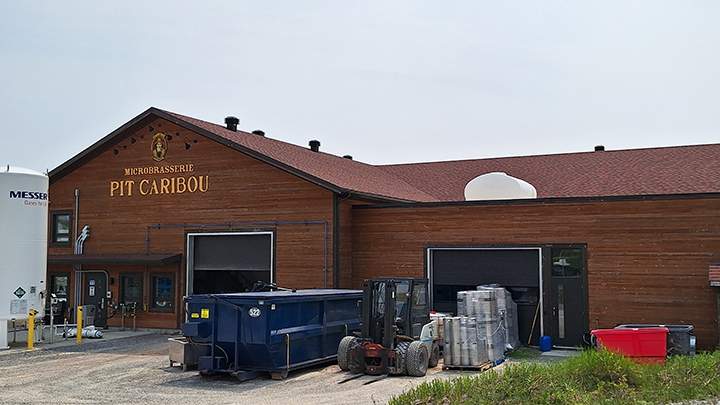The spirit of starting up: Les Marigots and the new wave of Gaspesian businesses
Arthur Poirier-Roy, LJI
This article marks the beginning of a new series for The Gaspé SPEC, one that seeks to understand the pulse of entrepreneurship here on the peninsula in the years since 2020. Why are people choosing to start businesses in Gaspésie now? What are the catalysts, the challenges, and the unexpected joys? To kick off this exploration, I sat down with Joseph St-Denis Boulanger, the owner, creator, and driving force behind Les Marigots distillery in Caplan. His story is a compelling window into the forces at play.
CAPLAN: – For ten years, Joseph worked as an engineer in Montreal. Life seemed set on a conventional path until, tragically, the death of his stillborn first child in 2018 served as a profound catalyst for change. Borrowing a Westfalia van, he and his family embarked on a trip back to his native Gaspésie. After 15 years away, this return to his roots wasn’t just a visit; it was the beginning of a complete recalibration, a search for a new project for life.
Joseph admits he’s always been a devotee of the pleasures of the table – food and drink. While food production was considered, the industry’s complexities led him towards distilling. It was a practical choice born from a passion for the sensory experience of eating and drinking, a choice that swiftly blossomed into a deep passion for the craft itself.
While there are several other distilleries making gin in Gaspésie, Joseph found a way to distinguish Les Marigots early on. His most prized possession, a handmade copper alambic imported from Cognac, France, is central to this. Unlike standard stainless steel stills, the artisanal copper machine offers superior bacterial control and, crucially, positively impacts the flavour profile of the spirits. As Joseph puts it with conviction, “You can make good spirit with any pot still, but to make an exceptional spirit, you need an exceptional still.”
Initially, whiskey was the primary goal, a long-term endeavour producing only a few hundred bottles annually after years of aging. But the process of developing their gin revealed an unexpected joy. Gin production became their immediate focus and, ultimately, their claim to fame. It’s on gin, produced in the tens of thousands of bottles yearly, that Les Marigots thrives. Joseph discovered a passion in the experimental, kitchen-like process of mixing and testing ingredients. The first Les Marigots gin, featuring around 14 carefully selected botanicals, was the result of extensive trial and error, a creative process Joseph clearly relishes, contrasting it with the more rigorous, chemistry-like discipline of whiskey making.
Crucially, these ingredients don’t come from a generic corporate supplier. They are sourced directly from the Gaspésian landscape – berries picked from the forest, leaves from specific trees, even bushes found along rivers. “What is tasted in a Marigots’ gin is the very land on which we walk,” Joseph states, connecting his product directly to its environment.
Being based in Gaspésie is not a disadvantage for Joseph; he sees it as inherent marketing. He believes the very name “Gaspésie” adds value and draws visitors to his unique building in Caplan in a way a city location never could. He actively collaborates with local producers like Arbor & Flora, Naufrageur, La Ferme Bourdages, Gaspésie Sauvages, and La Cigale et la Fourmis for ingredients, further embedding his business in the local ecosystem.
Moreover, Joseph highlights the supportive environment for new businesses here. He found local institutions welcoming and significantly helpful, describing it as a major advantage for newcomers. There’s a tangible sense of local pride in the venture; Joseph has even had volunteers offer their help, spreading the word about Les Marigots throughout the community.
Joseph St-Denis Boulanger’s journey from Montreal engineer to Gaspésian distiller is a rich tapestry woven from personal change, practical choices, unexpected passion, and a deep connection to place. It’s a powerful first example in our series exploring the driving forces behind the entrepreneurs shaping the future of business in Gaspésie today.
The warmth and wonder of the wood at Les Marigots
A visit to Les Marigots distillery in Caplan offers a compelling, large-scale example of timber’s potential in modern construction. Joseph St-Denis Boulanger, the visionary behind this ambitious project, didn’t opt for concrete, steel, or cheaper alternatives when planning his distillery building; he chose wood, massive, locally sourced timber crafted by Art Massif of St-Jean Port Joli.
Stepping inside the enormous structure, which stretches impressively in length and height, the immediate sensation is one of warmth. Joseph confirms this was his primary motivation. “It was about the warmth it brings,” he explained, the natural grain and hues of the wood creating an inviting, almost living atmosphere that simply cannot be replicated by colder materials. The building isn’t just a functional space for brewing spirits; it was conceived as an integral part of Les Marigots’ identity – a piece of art, an economic engine, and a fundamentally human space.
Joseph’s vision was challenging, requiring compromise with engineers to achieve his desired open concept. While he initially aimed for a completely column-free space, one necessary support column stands as a reminder of engineering realities. However, the result is breathtaking: vast open sections punctuated by intricate, crossing timber structures that soar overhead, holding the roof with a graceful strength that feels both ancient and utterly contemporary. It’s a space where engineering meets art in perfect harmony.
Beyond the aesthetic appeal and welcoming feel, Joseph emphasized the practical and ethical benefits of his choice. While far from the least expensive option upfront, wood offers exceptional durability.
Furthermore, selecting timber meant choosing a material that acts as a carbon sink, capturing and storing carbon dioxide for the lifetime of the building – a decision aligning perfectly with the values he, his family, and his company embody. It’s an investment not just in a physical structure, but in sustainability.
Joseph sees the building itself as his most significant protreptical investment – a term referring to an inspiring or persuasive appeal. Instead of vast marketing campaigns, the sheer beauty and unique presence of the wooden building draw people in from afar. And while the RACJ initially expressed concerns about moisture and humidity in a distillery, Joseph fought for his material choice, understanding that modern timber alloys, as Art Massif demonstrates with their work on pools and other demanding structures, are perfectly capable of handling such conditions. He conceded on many legal and technical points during the project, but the battle for the wood was one he thankfully won.

Considering the immense mass of carbon now locked away within these beautiful wooden walls and the undeniable beauty they add to the Caplan landscape, his determination was well-placed. In an era where expediency often dictates construction choices, Les Marigots stands as a powerful example of the immense long-term value, both for the planet and, eventually, the pocketbook, of investing in durable, beautiful, and environmentally conscious materials like wood. These buildings are built to last, a solid foundation for future success.
The spirit of starting up: Les Marigots and the new wave of Gaspesian businesses Read More »
















































